Traveling around Vietnam and don’t know if you want to stay in Da Nang or Hoi An? Fair enough – As it’s like choosing between an adrenaline-packed movie and a soul-soothing classic film.
On one hand, there’s Da Nang, a dynamic city where the pace never slows, offering stunning beaches and great nightlife. On the other, there’s Hoi An, a place where time seems to stand still, and where you can wander through its lantern-lit streets and learn about its history.
I spent a few months in Da Nang and traveled around Hoi An extensively several times, and I’m now ready to share everything with you.
Want to know more? Let’s break it down and see which one might just be the one for you!
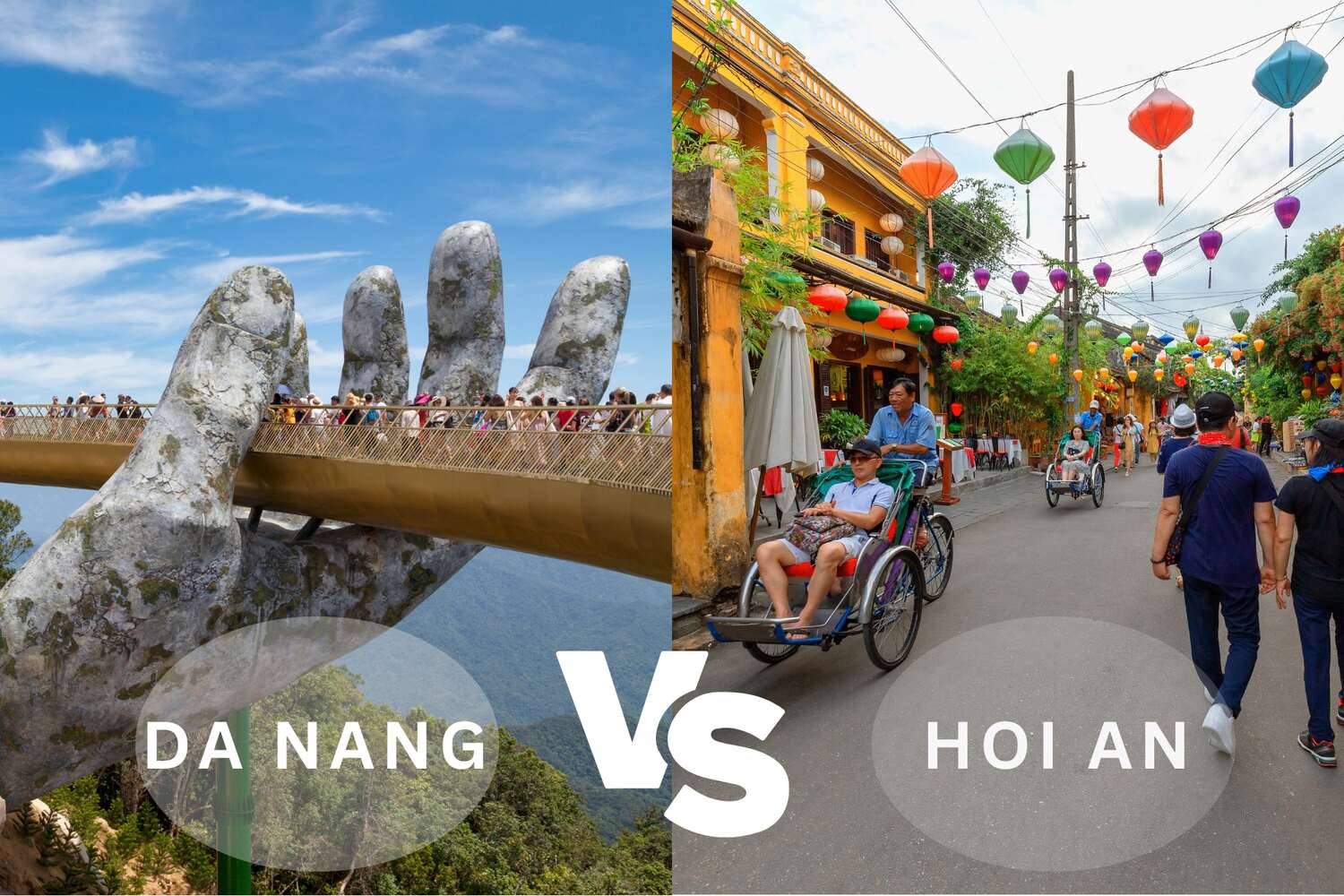
Table of Contents ⬇️
ToggleSummary: Da Nang or Hoi An
I understand you might not have the time to go through the whole guide, so here’s a quick overview of the two cities to help you decide:
Da Nang is better for beaches, traveling around Central Vietnam, and nightlife
Hoi An is better for history lovers, the night market, and the lovely streets with lanterns
Of course, if you have more time available, make sure to read until the end as you’ll find all the information you need before visiting Central Vietnam!
Da Nang vs Hoi An – Ultimate Comparison
Now that you know the essentials, let’s go into more details with everything you should know about both Da Nang and Hoi An. I’ve divided this section into several categories, from the tourist attractions to the accommodation options to the weather and more.
Make sure to ready until before booking your hotel in either Da Nang or Hoi An!
Things to Do in Da Nang VS Hoi An
When you’re comparing Da Nang and Hoi An, the activities on offer are as distinct as the cities themselves.
Da Nang is perfect for those seeking adventure and modern attractions, with highlights like My Khe Beach, Ba Na Hills and the longest cable car ride in the world, and the iconic Dragon Bridge and its weekend show.
Hoi An offers a cultural dive into the past, featuring bike rides, traditional crafts, and peaceful boat rides on the Thu Bon River.
Things to Do in Da Nang
Da Nang is a fun city that packs a punch with its array of activities. Start with the stunning My Khe Beach, perfect for sun-seekers and surfers, with its long stretch of white sand and crystal-clear waters.
Don’t miss the famous Marble Mountains, a fascinating mix of natural caves, Buddhist sanctuaries, and breathtaking views.
For thrill-seekers, the Ba Na Hills and its famous Golden Bridge offer a unique blend of amusement park excitement and scenic beauty.
And as the sun sets, the Dragon Bridge lights up the night sky, a modern marvel that breathes fire and water, which is super fun, and you can then head to Asia Park and the famous wheel!
Lastly, don’t miss the museums in town, such as the Cham Museum and the city museum to learn more about Da Nang’s history. More about this in the guide here below.
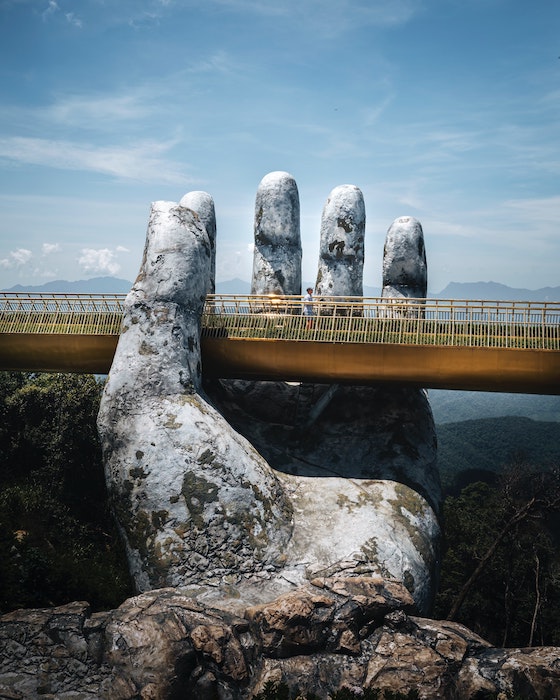
Want to know more?
Here’s a complete guide about the
best tourist spots in Da Nang.
Things to Do in Hoi An
Hoi An Ancient Town, a UNESCO World Heritage site, is a must-visit, with its beautifully preserved architecture, historical sites, and lantern-lit streets offering a glimpse into the past.
Here, you can take a leisurely bike ride through the rice paddies, learn about traditional Vietnamese crafts, or enjoy a cooking class.
The Night Market and lantern-lit boat rides on the Thu Bon River offer a more relaxed, cultural experience, which are amazing when visiting Hoi An.
For a taste of local craftsmanship, attend a lantern-making workshop or explore the numerous tailor shops for custom-made clothes. The Night Market is another highlight, bustling with vendors selling local handicrafts, street food, and the town’s iconic lanterns.
Hoi An’s blend of history, culture, and natural beauty makes it an unforgettable destination in Vietnam!
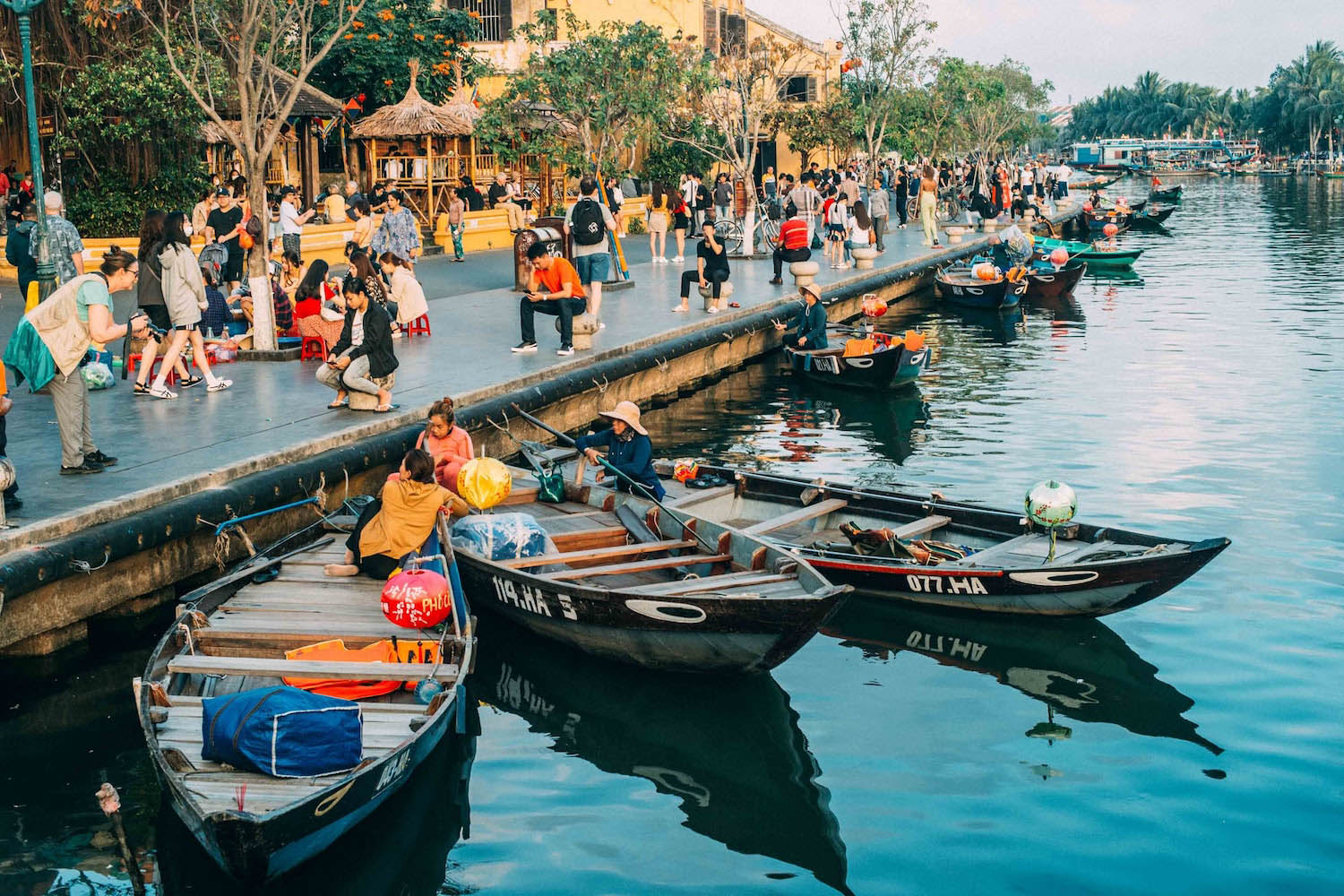
Want to know more?
Check out this guide about the
best tourist activities in Hoi An.

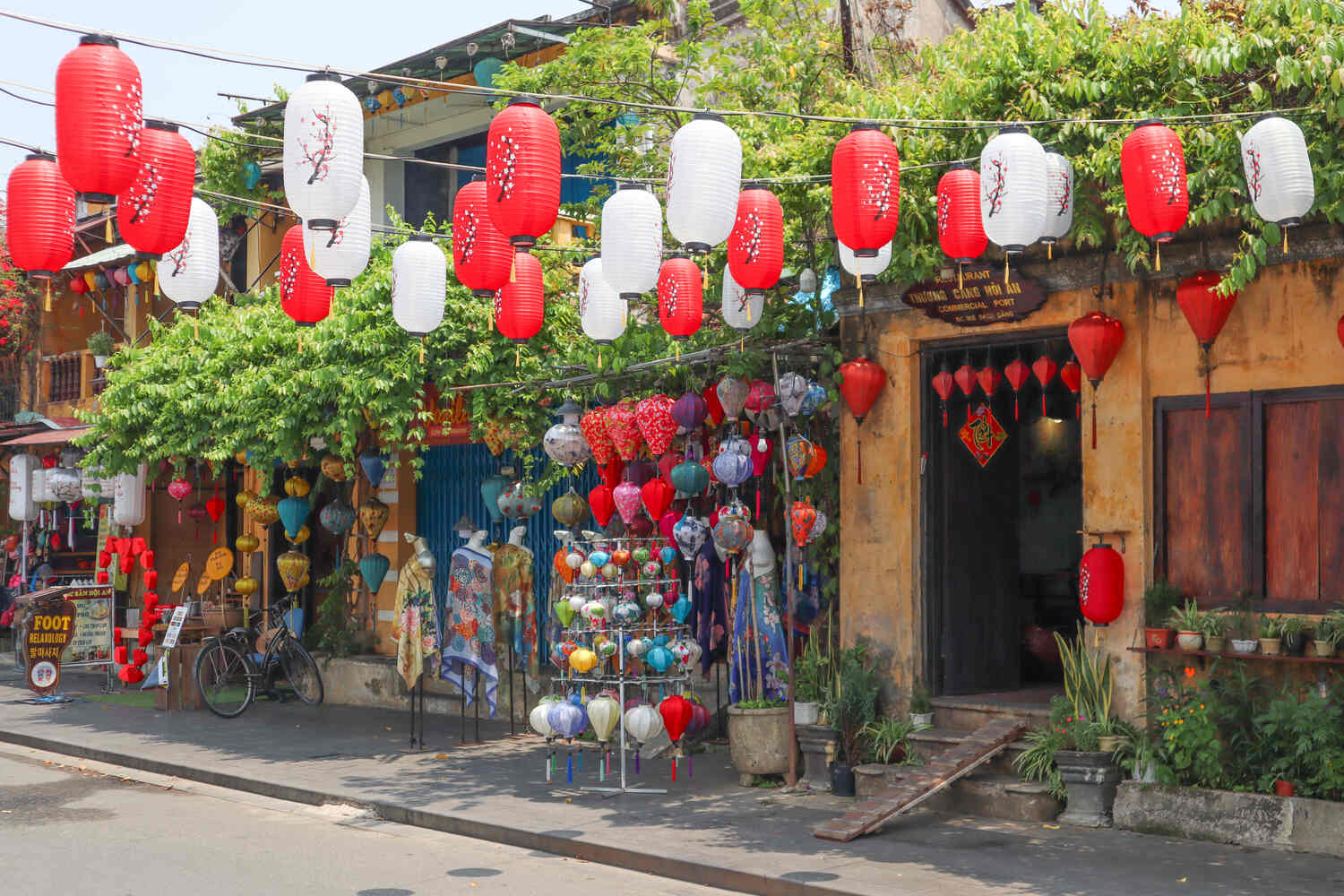
Weather
Da Nang experiences varied weather, with the best visit times between February and May to avoid rainy seasons. Hoi An shares similar weather patterns but is prone to flooding during rainy seasons, with its charm peaking in clear, dry periods.
Weather in Da Nang
Da Nang’s weather can be a bit of a roller coaster, with hot, dry summers and cool, wet winters. The best time to visit is between February and May when the weather is mild and pleasant.
This period avoids the peak rainy season from September to December, where your plans might be washed out (pun intended!). Truth be told, mornings are often cloudy with gray skies, while afternoon are usually sunny with a clear sky, and that’s the best moment to hit the beach.
Weather in Hoi An
Hoi An, just a short drive away, shares a similar climate but tends to flood during the rainy season. The ancient town’s charm shines in the dry season, with clear skies perfect for exploring the streets and countryside.
That said, Hoi An is a very humid place, and it’s not easy to find cafes with air conditioning, so be prepared for the heat!
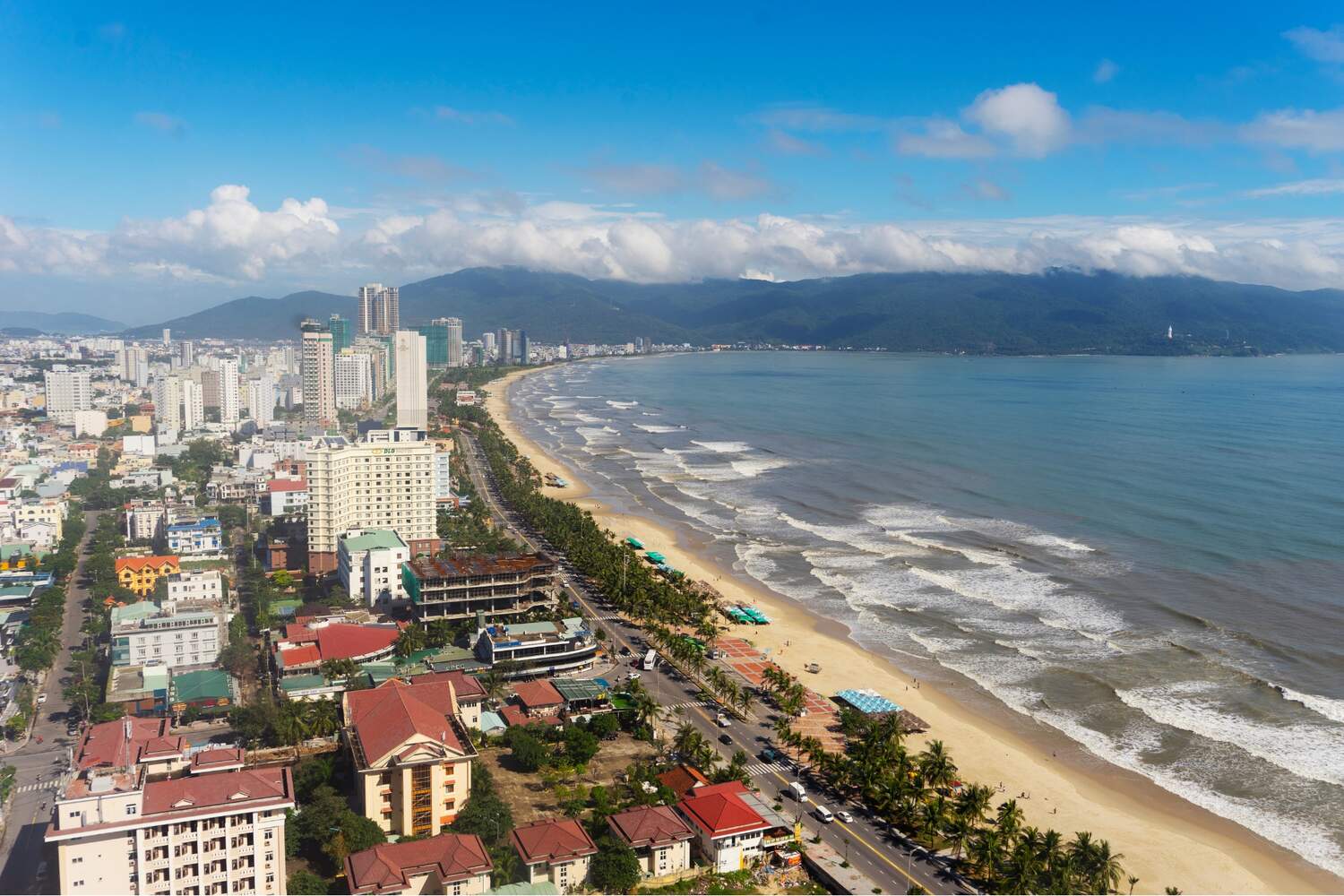
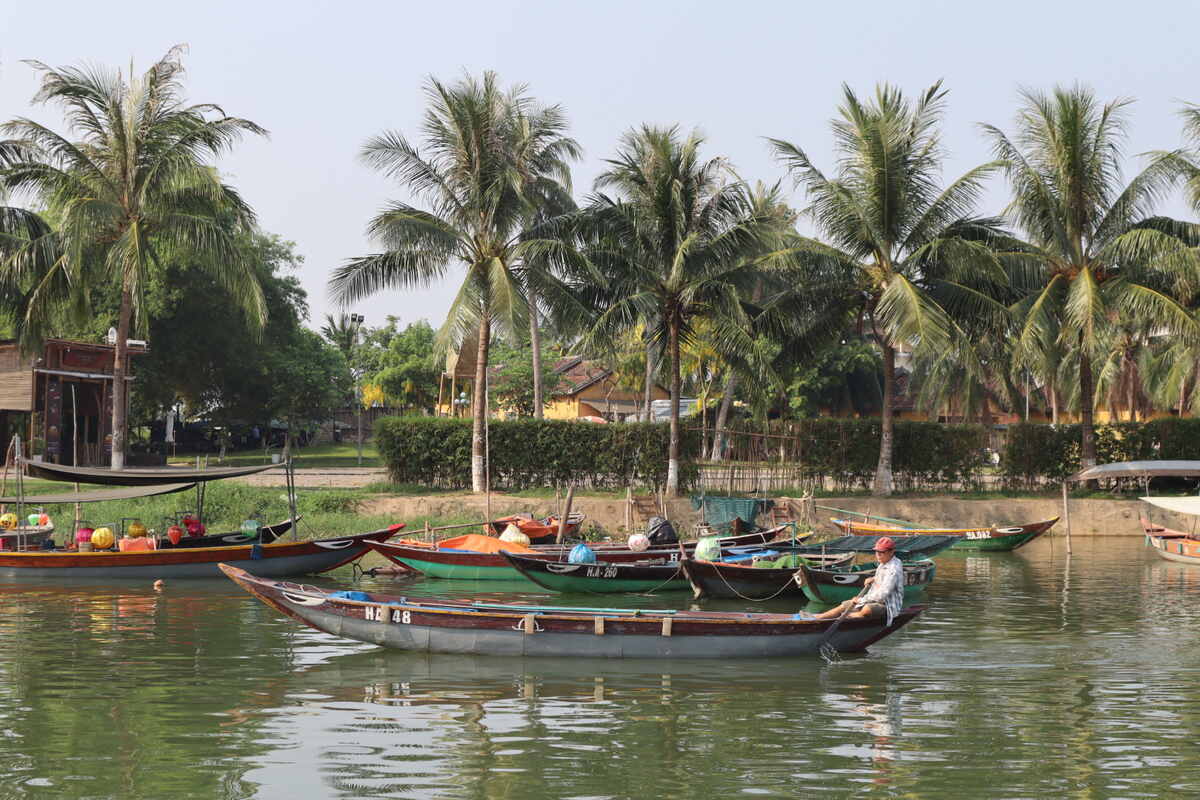
Safety
Da Nang is among Vietnam’s safest cities, offering a secure environment with a focus on keeping visitors safe. Hoi An, while also very safe, presents a quaint, welcoming atmosphere, though you should be cautious at night due to limited street lighting.
Safety in Da Nang
Da Nang is known for being one of Vietnam’s safest cities for tourists. The streets are well-lit, and the local police keep a close watch, ensuring that visitors can feel secure day and night.
Like any city, it’s smart to keep an eye on your belongings and avoid less crowded areas late at night. Road safety is another aspect to pay attention to, especially when crossing streets or renting motorbikes (please don’t drive if that’s your first time!).
Safety in Hoi An
Hoi An is as safe as it is lovely. The town’s laid-back atmosphere extends to its approach to security, with low crime rates and a friendly local population that’s welcoming to tourists.
Walking around the ancient town at night is generally safe, thanks to the well-lit streets and gentle flow of fellow night wanderers. Just be cautious on rural roads outside the main town, especially if you’re cycling around Hoi An or walking at night, as lighting can be minimal.
Overall, Hoi An’s safety makes it an easy place to relax and enjoy without significant concern.
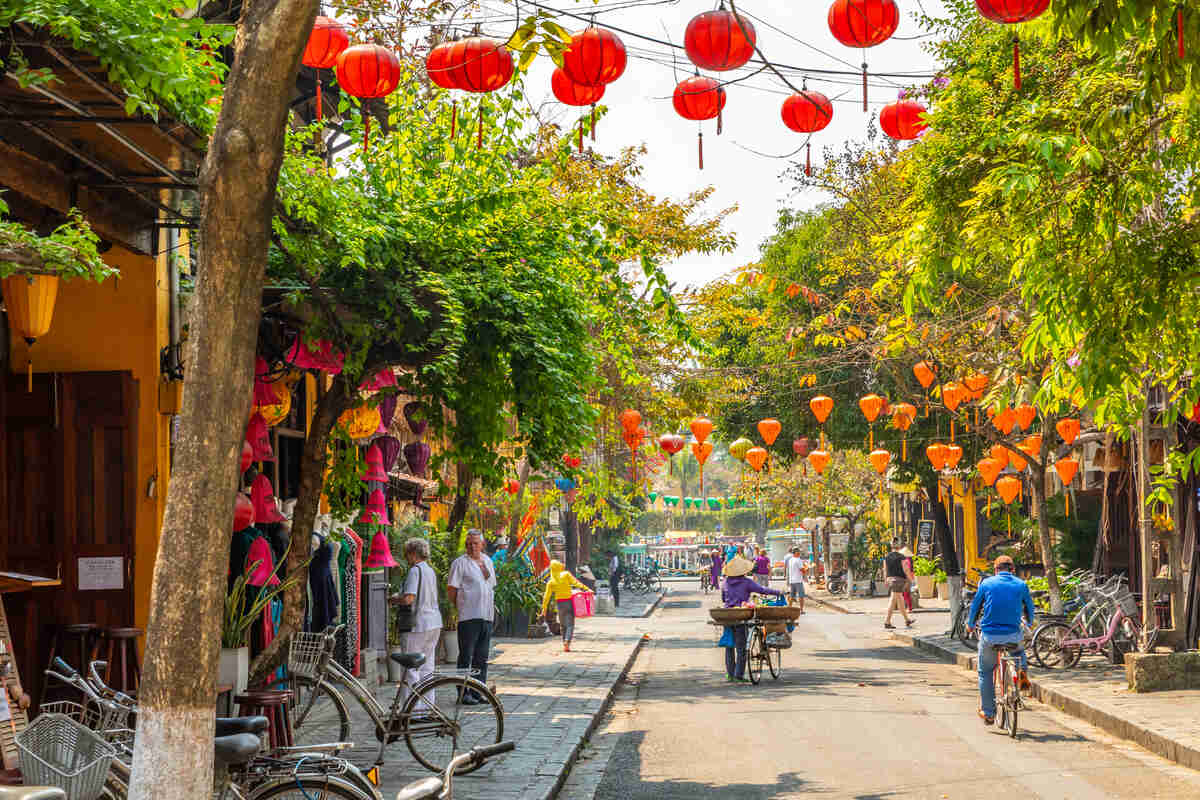
Hotel Options
Da Nang caters to all budgets, offering everything from luxury beachfront resorts to affordable city hostels. Hoi An is best for charming, historical accommodations, providing a unique stay in restored houses or riverside villas with traditional decor.
Accommodation in Da Nang
Da Nang’s accommodation scene is as varied as its landscapes, offering everything from beachfront resorts to cozy hostels in the city center.
If you’re after luxury, Da Nang’s luxury resorts along My Khe Beach won’t disappoint, providing stunning sea views and first-class amenities. For travelers on a tighter budget, the city center is your best bet, with plenty of affordable options that still offer great service and comfort.
Many places blend modern comforts with local design, ensuring a stay that’s both comfortable and culturally enriching. Whether you want the sea at your doorstep or to be in the heart of the city, Da Nang delivers.
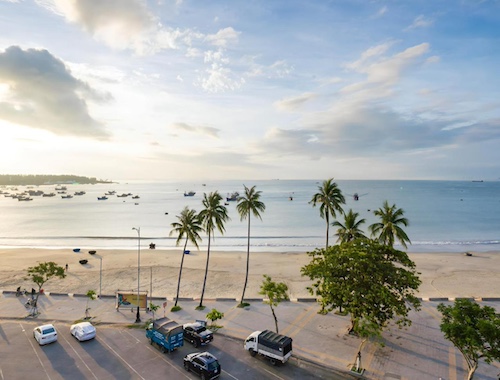
Related Guide
Here are the best places
where to stay in Da Nang City.
Accommodation in Hoi An
Hoi An’s lodging is more about charm and history. You can stay in beautifully restored historic houses turned hotels right in the heart of the ancient town or choose a riverside villa for a tranquil retreat.
Boutique hotels here often feature traditional Vietnamese decor, offering a unique experience compared to standard accommodations.

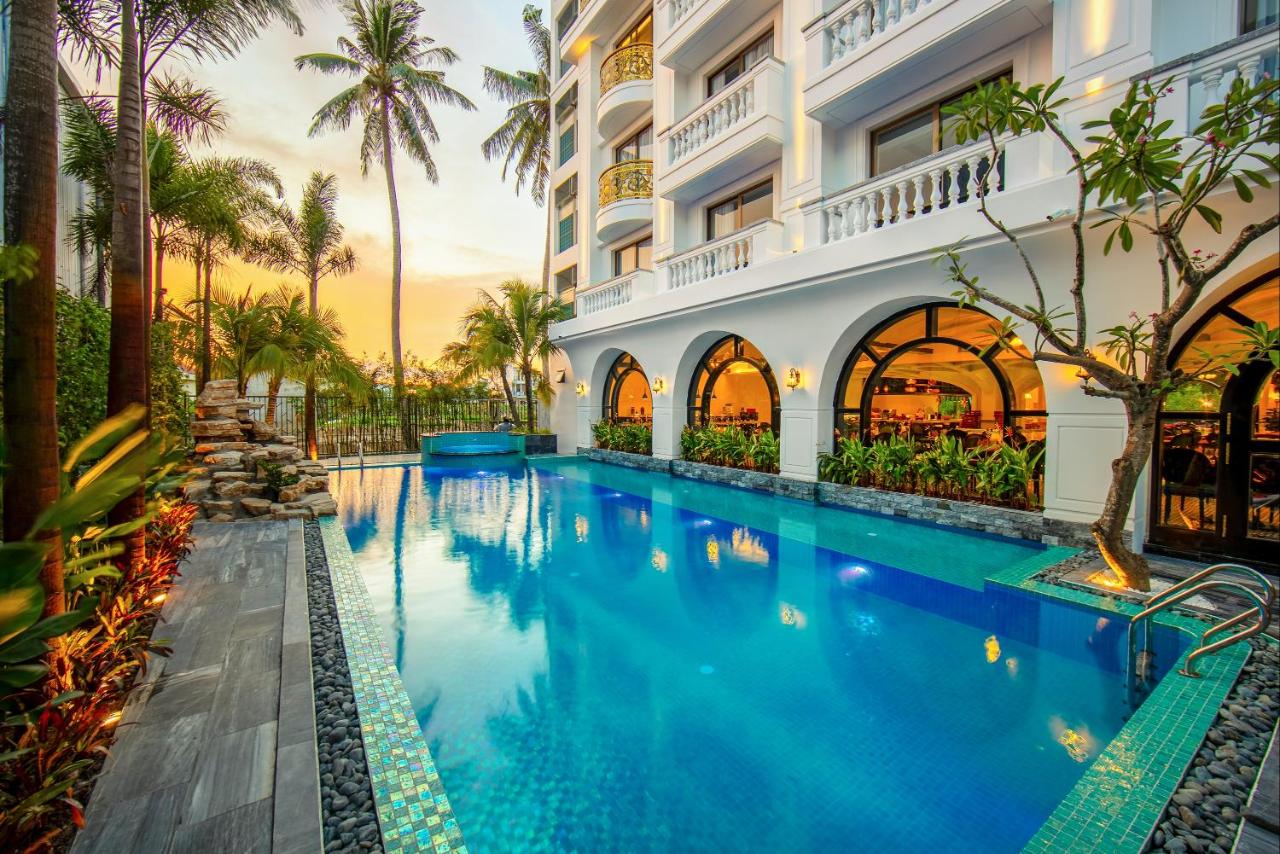
Day Trips
Hoi An day trips lean towards cultural experiences and relaxation, like visiting My Son Sanctuary or exploring rural landscapes. The Cham Islands provide a serene beach getaway.
Da Nang, in contrast, offers a broader array of day trips, including historical Hue, adventurous excursions to Phong Nha-Ke Bang National Park, and the modern Ba Na Hills theme park, making it a hub for diverse activities and day tours.
Day Trips from Da Nang
Da Nang serves as a fantastic base for exploring Central Vietnam. A trip to the ancient capital of Hue reveals a city brimming with royal history, from the imposing Imperial City to the serene Thien Mu Pagoda.
Plus, if you travel from Da Nang to Hue, you’ll get to pass on the Hai Van Pass and see incredible views on the way!
The Marble Mountains offer a closer adventure, with their stunning caves and Buddhist sanctuaries just a short drive away. Many people visit the mountains and Lady Buddha in Son Tra Peninsula on the same day, and I recommend you do the same.
For nature lovers, a journey to the Ba Na Hills reveals not only the famous Golden Bridge but also a cooler climate and panoramic views. Each trip from Da Nang offers a unique glimpse into the diverse cultural and natural beauty of the region.
It’s worth noting that you can also take a day trip from Da Nang to Hoi An, in case you end up staying in the former.
Day Trips from Hoi An
Day trips from Hoi An often focus on culture and relaxation. You might visit My Son Sanctuary, a UNESCO World Heritage site with ancient Hindu temples. My Son is thought to be the ancient capital of the Champa Kingdom, and I’m confident you’ll love the visit.
Or, explore the rural beauty of the Vietnamese countryside on a bike tour, stopping at local farms and villages. The Cham Islands, on the other hand, offer a perfect escape for snorkeling and beach time.
You can also get from Hoi An to the Marble Mountains, which is a nice alternative if you plan to stay here instead of Da Nang.
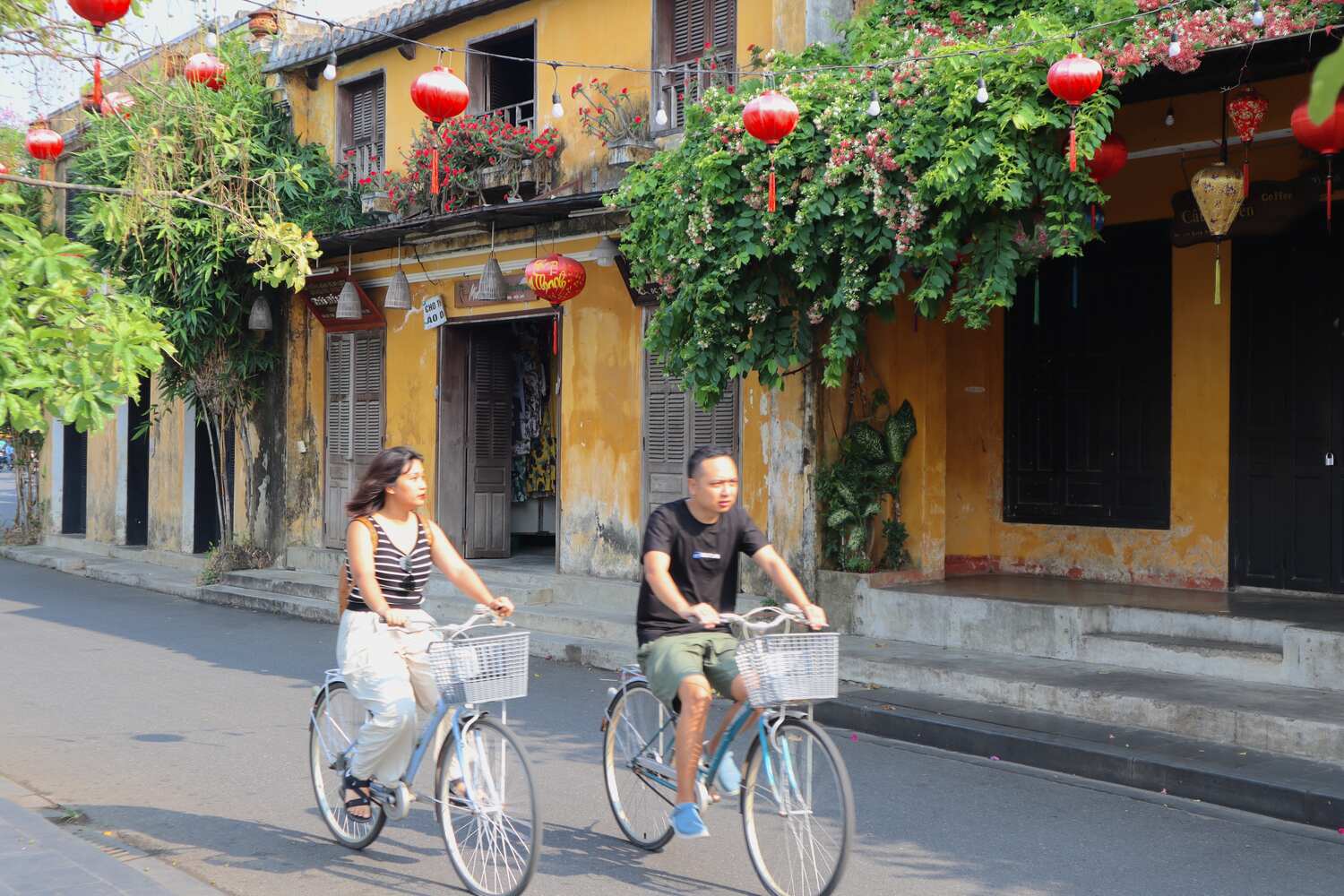
Want to know more?
Check out this guide about taking
a day trip to Hoi An from Da Nang.
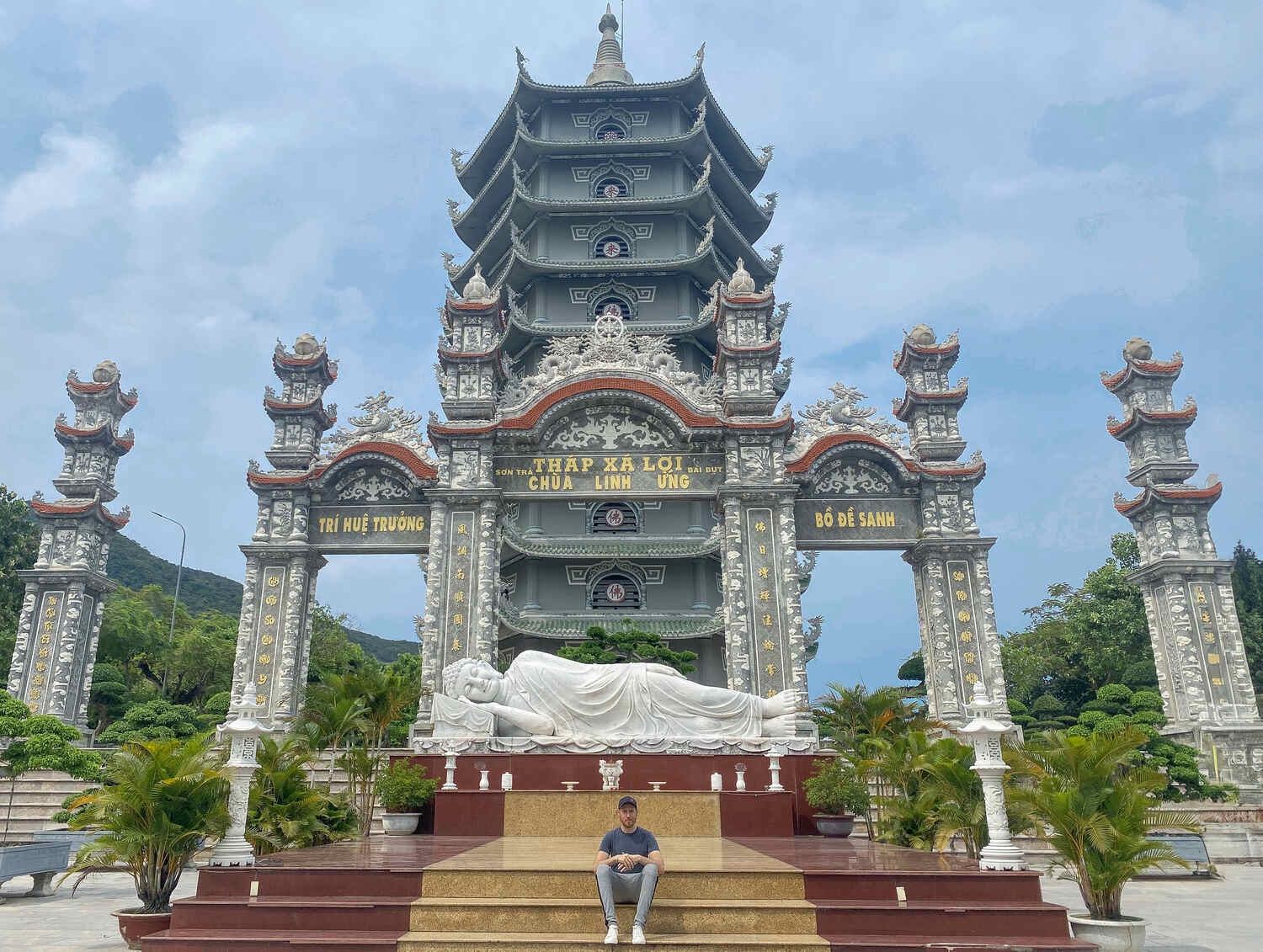
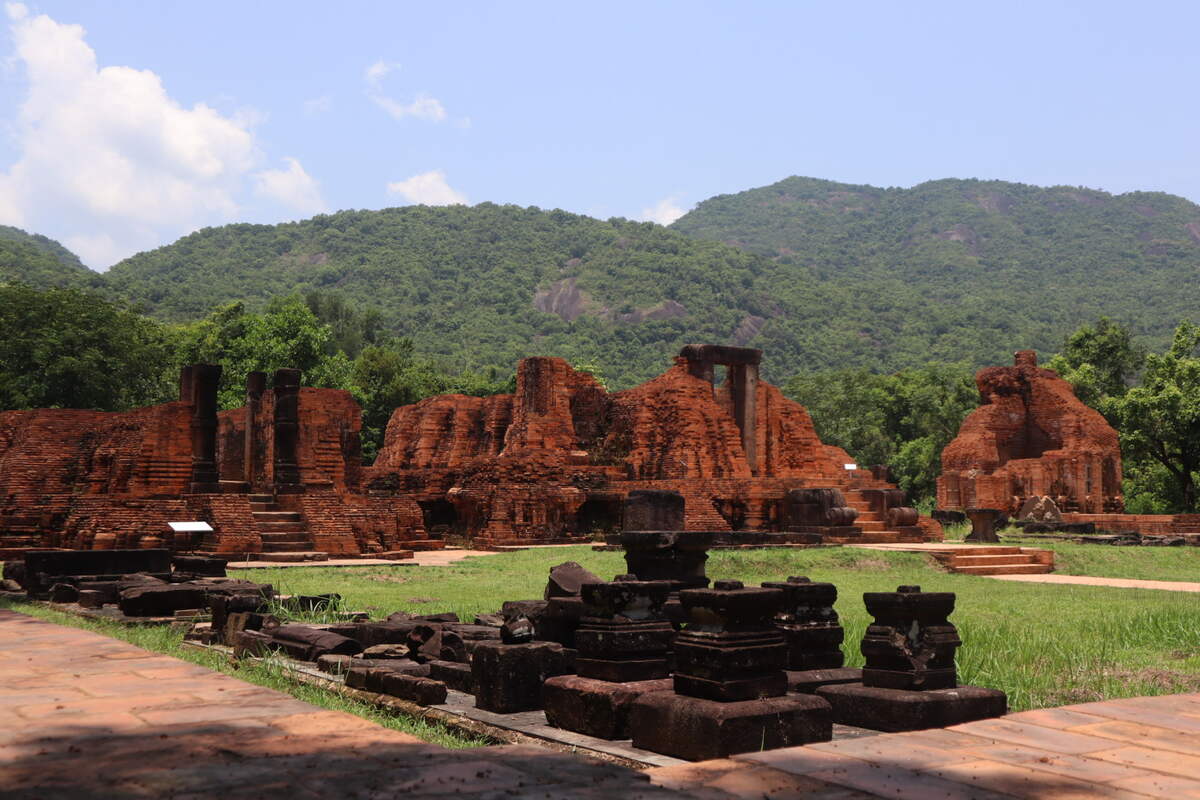
Food Scene
Da Nang’s food scene is a nice mix of traditional Vietnamese flavors and international influences, making it a great choice for foodies.
The city is renowned for its seafood, with grilled mackerel and shrimp pancakes as popular dishes. Local specialties like Mi Quang, a turmeric noodle dish, and Banh Xeo, a crispy crepe, showcase Da Nang’s rich culinary traditions and the fusion of fresh ingredients and age-old cooking techniques.
Apart from that, you’ll find plenty of international restaurants, which is great if you miss the food from your country.
In contrast, Hoi An offers a culinary journey steeped in history, with dishes that have been passed down through generations. Unique to Hoi An, Cao Lau combines noodles, pork, and greens in a way that captures the essence of the town.
The iconic Banh Mi Hoi An and the simple yet delicious Hoi An Chicken Rice further highlight the town’s commitment to preserving its culinary heritage, providing a taste of history with every bite.
Food in Da Nang
The food scene in Da Nang is as dynamic as the city itself, blending traditional Vietnamese flavors with international cuisines.
Da Nang’s culinary scene is a melting pot of flavors. Seafood is a big deal here, with dishes like grilled mackerel and shrimp pancakes topping the list of must-tries.
Mi Quang, a turmeric noodle dish served with a rich broth and a variety of meats, is a local favorite you can’t miss.
Another standout is Banh Xeo, a crispy crepe filled with shrimp and bean sprouts, perfect for a savory snack. Each of these dishes tells a story of Da Nang’s rich culinary heritage, blending fresh ingredients with traditional Vietnamese cooking techniques.
Food in Hoi An
Hoi An’s food is as historic as its streets. Cao Lau, a dish you’ll only find in Hoi An, combines thick noodles, pork, and local greens, distinguished by its unique taste from the ancient town’s well water.
Banh Mi Hoi An is another winner, with its crispy baguette filled with seasoned pork, pate, and veggies.
Don’t overlook the Hoi An Chicken Rice, a simple yet flavorful dish that’s become a lunchtime staple. Each bite in Hoi An is a taste of history, crafted from recipes passed down through generations.




Beaches
Da Nang and Hoi An offer contrasting beach experiences that cater to different preferences. Da Nang is renowned for its stunning beaches like My Khe, famous for soft white sands and clear blue waters, making it perfect for sunbathing, swimming, and surfing opportunities.
Non Nuoc Beach provides a quieter alternative for those looking to escape the crowds.
Hoi An’s beaches, particularly An Bang Beach, offer a more laid-back atmosphere with less commercialization, ideal for a calmer experience and a chance to unwind in a more intimate setting.
Although Cua Dai Beach has faced challenges with erosion, it still remains a beautiful spot for relaxation. Unlike the convenient beach access in Da Nang, reaching Hoi An’s beaches requires a bit of travel from the city, adding to their secluded charm.
Beaches in Da Nang
Da Nang boasts some of Vietnam’s most stunning beaches, with My Khe Beach leading the pack.
Known for its soft white sand and clear blue waters, it’s a hotspot for sunbathing, swimming, and surfing. The beaches here are well-maintained, with plenty of amenities like loungers, umbrellas, and beachside cafes.
Non Nuoc Beach is another gem, offering a more tranquil setting away from the crowds.
Beaches in Hoi An
Hoi An, by contrast, offers a quieter beach experience. An Bang Beach is the go-to spot, where the vibe is laid-back and the food is delicious.
It’s less commercialized than Da Nang’s beaches, providing a more intimate setting to relax and soak up the sun. Cua Dai Beach is another option, though it has suffered from erosion in recent years.
Unlike Da Nang, where the beaches are right in town with areas to stay like My An within walking distance, the beaches in Hoi An are a little far from the city, and you’ll have to drive there.
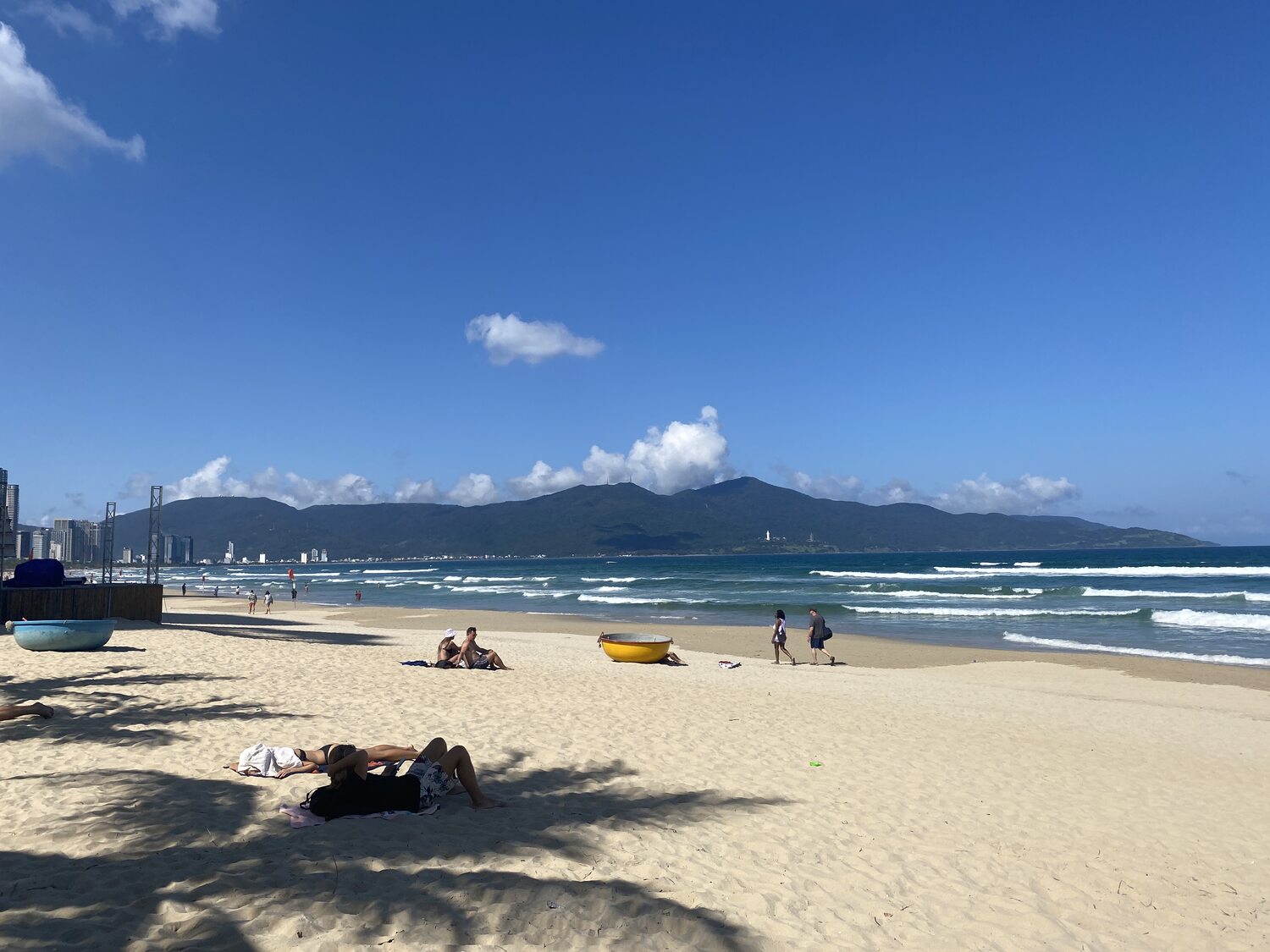
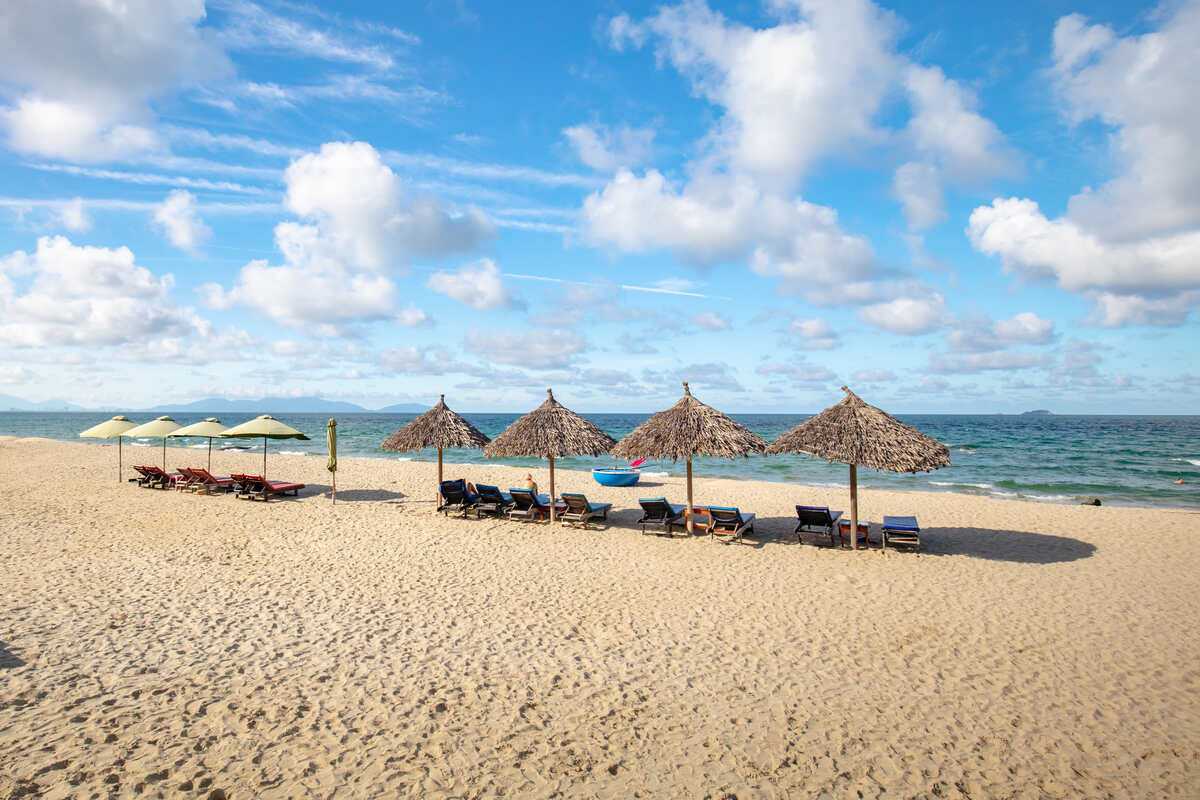
Da Nang Airport
Da Nang International Airport serves as the main gateway for travelers to both Da Nang and Hoi An. It’s conveniently located just a few kilometers from the center of Da Nang, making it easily accessible.
The airport is well-equipped with facilities and offers direct flights to major cities in Asia and beyond. From the airport, Hoi An is about a 45-minute drive away.
There are several transport options available, including taxis, private cars, and shuttle buses, making it easy to reach your destination whether you’re headed to the bustling city of Da Nang or the tranquil streets of Hoi An.
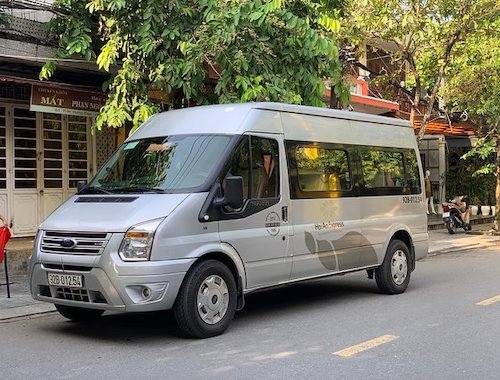
Want to know more?
Check out this guide about
getting from Da Nang to Hoi An.
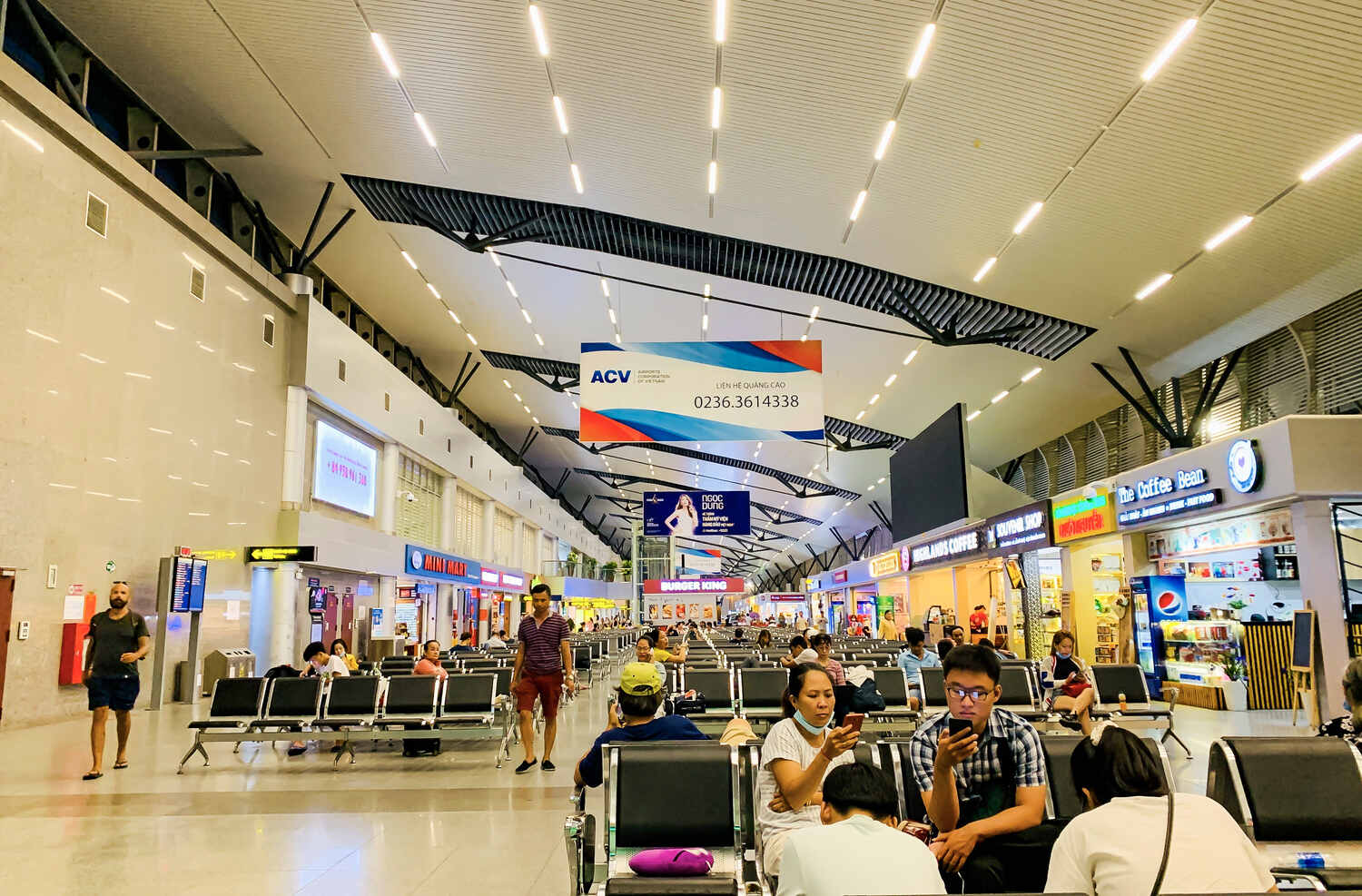
Nightlife
Da Nang and Hoi An have distinct nightlife experiences reflective of their unique characters. Da Nang’s nightlife is vibrant and diverse, with a mix of rooftop bars, nightclubs, and live music venues catering to all tastes.
In contrast, Hoi An offers a calmer night scene, with its ancient town aglow with lanterns. Its nightlife is centered around quiet riverside bars, live music, and the Night Market, providing a peaceful yet engaging atmosphere.
Nightlife in Da Nang
Da Nang shines when the sun goes down, offering a nightlife scene that caters to all tastes. From rooftop bars with panoramic views of the city and river to bustling nightclubs where you can dance until dawn, there’s no shortage of spots to enjoy a night out.
The city also hosts a variety of live music venues, offering everything from jazz to traditional Vietnamese performances.
The best area for nightlife in Da Nang is My An, right by My An and My Khe beaches, and you’ll find pubs, restaurants open until late, a small night market, and live music spots. Alternatively, consider having a drink at Sky Bar 21 – You’ll love the views!
Nightlife in Hoi An
Hoi An’s nightlife is more subdued but equally charming. The ancient town is magical at night, illuminated by hundreds of lanterns. You can enjoy a quiet drink at a riverside bar, listen to live music, or wander the Night Market, right in front of the Japanese Bridge.
For a unique experience, join a lantern-making workshop or take a lantern-lit boat ride on the Thu Bon River. While you won’t find the high-energy clubs of Da Nang, Hoi An offers a serene and culturally rich evening atmosphere.

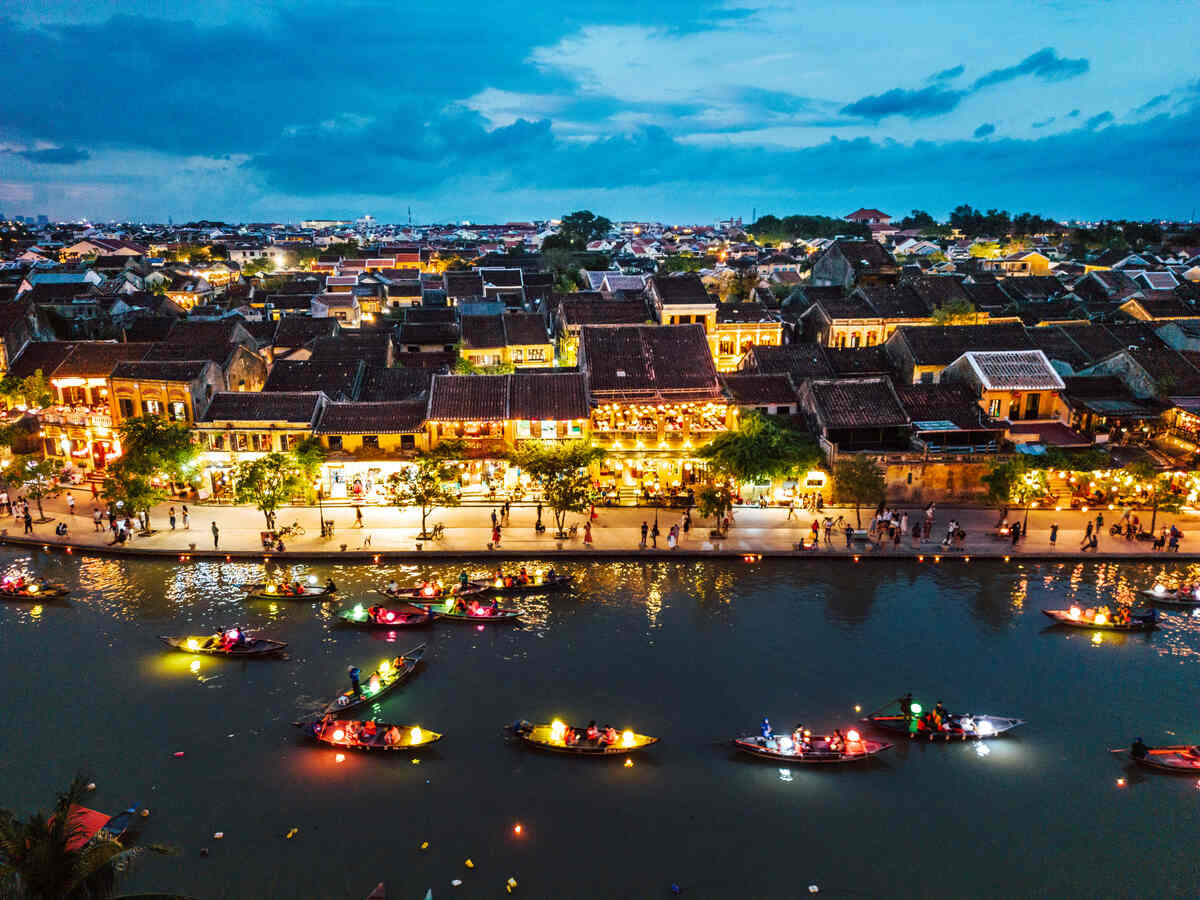
Shopping
Hoi An charms with traditional shopping, known for tailor-made clothing and handcrafted items, reflecting its rich heritage.
Da Nang presents a modern shopping landscape with malls and markets that offer a blend of international and local goods, catering to a wider range of preferences.
Shopping in Da Nang
Da Nang’s shopping scene is more modern. Malls like Vincom and Indochina Riverside offer international brands alongside local retailers.
For a more local experience, visit the Han Market or Con Market, where you can haggle for fresh produce, souvenirs, and textiles. While Hoi An offers a traditional and personalized shopping experience, Da Nang offers more choice, which I personally like.
Shopping in Hoi An
Hoi An’s shopping experience is as enchanting as its streets. The town is famous for its tailor shops, where you can get custom-made clothing at great prices.
Art galleries, souvenir shops, and markets like the Hoi An Night Market add to the charm, selling everything from handcrafted lanterns to local art.
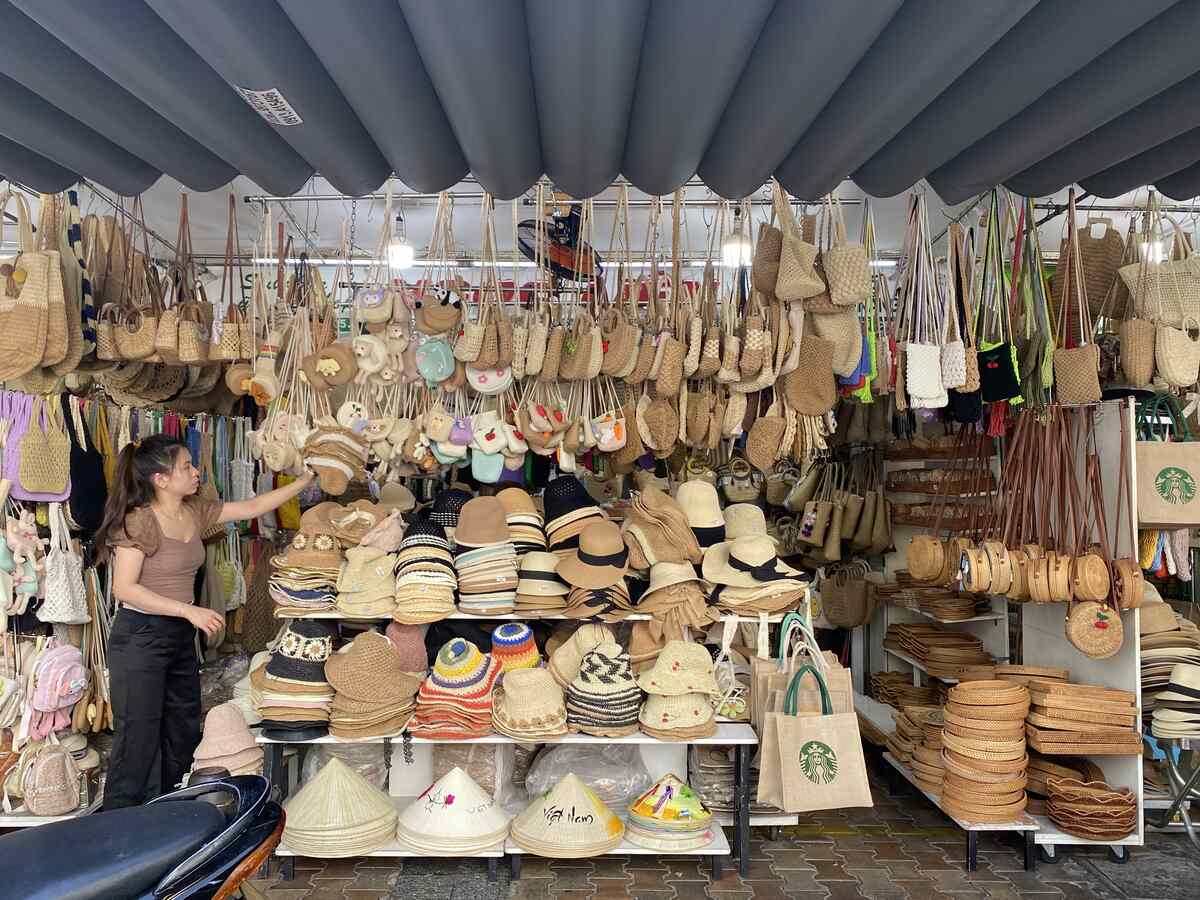
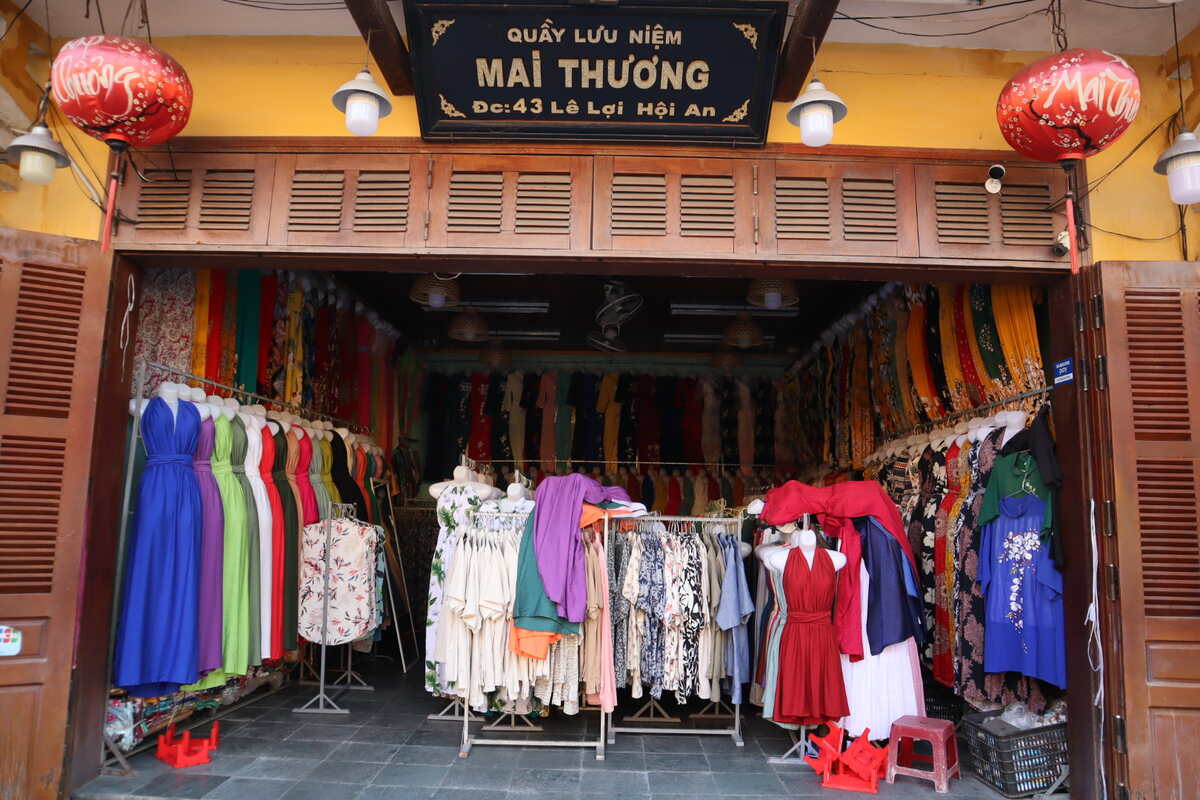
Transportation & Getting Around
You can easily get around Hoi An by bicycle or on foot (unless you want to hit the beach), offering a quaint, pleasant experience. For those venturing further, motorbikes are an option.
Da Nang’s larger size means more transportation options, including taxis, suitable for those preferring quicker and more convenient travel.
Transportation in Da Nang
Da Nang, being a larger city, offers a broader range of transportation options. Motorbikes and taxis are available, and the city also has a reliable bus system that connects major attractions, including Hoi An.
For those looking to explore the wider region, renting a car with a driver might be a more comfortable option. Da Nang’s infrastructure supports more extensive travel needs, making it suitable for visitors who prefer a faster pace and more convenience.
Transportation in Hoi An
Getting around Hoi An is easy, thanks to its compact size. Bicycles and walking are the best ways to explore the ancient town and its surroundings, offering a slower pace that suits the town’s laid-back vibe.
Motorbike rentals are available too, but do yourself a favor and avoid that if you’ve never driven a scooter before.
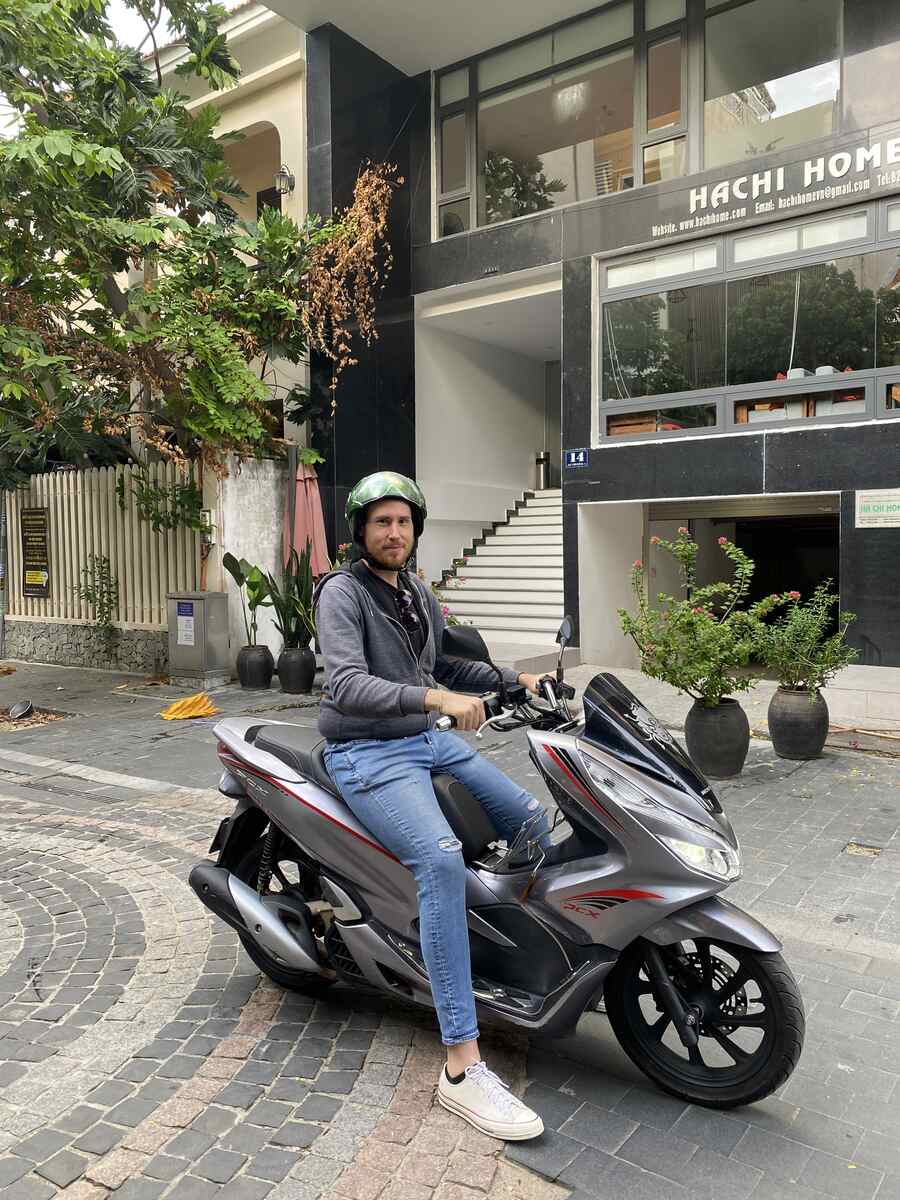
Prices in Hoi An VS Da Nang
Hoi An and Da Nang both provide good value, but Hoi An’s focus on tourism might lead to higher prices in the old town.
Da Nang, balancing tourist and local needs, generally offers more competitive pricing, especially for dining and accommodation, making it potentially more budget-friendly.
Prices in Da Nang
Da Nang, with its mix of locals and tourists, often has more competitive pricing. Dining out can be cheaper, especially if you stick to local eateries and street food.
Accommodation in Da Nang varies widely, from budget hostels to luxury resorts, often offering more value for money compared to Hoi An, where the focus is more on boutique and mid-range hotels.
Both locations are budget-friendly, but savvy travelers can stretch their money further in Da Nang with a little local know-how.
Prices in Hoi An
In comparing general prices between Hoi An and Da Nang, it’s important to note that both cities offer great value, but some differences can affect your budget.
Hoi An, with its quaint charm and emphasis on tourism, tends to have slightly higher prices in the heart of its Ancient Town.
Dining in restaurants, shopping for souvenirs, and experiencing local activities like cooking classes or lantern-making workshops might come at a premium due to their popularity and historical value (are they worth it though? Definitely).
Lastly, the hotels in Hoi An are slightly more expensive, but as a Western point of view, the difference is minimal.

Hoi An or Da Nang – FAQ
Now that you know what to expect in both places, let’s answer some questions from first-timers that you may find helpful too.
Can You Visit Both Da Nang and Hoi An?
Absolutely, visiting both Da Nang and Hoi An is not just possible, but highly recommended. These two cities offer contrasting experiences that, together, provide a comprehensive taste of Central Vietnam’s cultural depth and scenic beauty.
Spending 1-2 days in each city allows you to soak in Da Nang’s modern vibrancy, stunning beaches, and architectural marvels, and then switch gears to immerse yourself in Hoi An’s historic charm and rich heritage.
Where to Stay – Da Nang or Hoi An?
Deciding where to stay between Da Nang and Hoi An depends on what you’re looking for in your visit. If you’re after a bustling city vibe with access to modern amenities and beaches, then Da Nang is your go-to.
On the other hand, if you prefer a more laid-back atmosphere with a rich historical context, Hoi An is the place to be. The town is known for its charming boutique hotels and guesthouses, many of which are located within or close to the ancient town, offering a more intimate and cultural experience.
Conclusion: Hoi An or Da Nang, Which is Better? Hoi An!
So, there you have it. Da Nang and Hoi An, two faces of Central Vietnam, each with its unique charm and offerings.
Whether you lean towards the energetic vibes of Da Nang with its modern attractions and culinary delights or the tranquil allure of Hoi An with its historical depth and serene beaches, you’re in for a treat.
From a personal point of view, I prefer Da Nang to stay long term (and for having the most beautiful beaches), as I work online and travel, but if I were to choose one place to visit on holidays, it would be Hoi An.
Both places promise unforgettable experiences tailored to what you’re seeking, and I’m confident you’ll have an amazing time no matter what! Thanks for reading the end and I hope the comparison helped you plan your trip!



